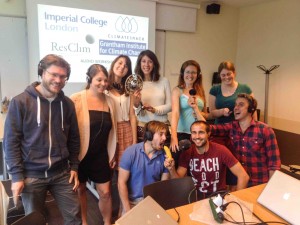 There’s a whole wave of new and exciting ways to communicate our science. There are blogs, video abstracts, animations, podcasts and a whole lot more. With all these options, we might get overwhelmed. We might get so overwhelmed that we just leave all these things up to the experts. What we might not realize is that we can easily learn the basic skills for some of these media and apply them successfully. This is what we did last week in London at ClimateSnack’s very first audio workshop (aka podcast course).
There’s a whole wave of new and exciting ways to communicate our science. There are blogs, video abstracts, animations, podcasts and a whole lot more. With all these options, we might get overwhelmed. We might get so overwhelmed that we just leave all these things up to the experts. What we might not realize is that we can easily learn the basic skills for some of these media and apply them successfully. This is what we did last week in London at ClimateSnack’s very first audio workshop (aka podcast course).
Amongst other things, ClimateSnack advocates for improved story-telling in science so that we can better communicate to any audience. In ClimateSnack we primarily train these story-telling skills through writing, but we can also apply these skills to other media. In a podcast, the story-telling elements might be similar to a piece of writing. However, when we make these podcasts, we have to consider many other issues.
We need to think about technical and editorial issues. Technical issues include the direction of the microphone, background noise, echoes, input volumes and so on. On the editorial side, we need to consider how to work with our own voices, how to deliver a script, and how to edit our recordings.
As we learn about all these issues, we start to appreciate the potential power of audio in science communication. In much the same way as photographs can spark our imagination, sounds can transport our thoughts to different locations, conjure up different feelings, or simply hold our attention. At the audio workshop, we learnt all about how we can use sound to tell a scientific story, along with all the technical and editorial skills we needed to make our own podcasts.
Much to our surprise, at the end of the 3-day course, all of us had audible versions of our very own podcasts. Some of us told the stories of our own science. Some of us told the stories of other people’s science through interviews. Whatever we did, we really started to understand how we could use audio to communicate science to any audience. At the end of the course Rachel White from Imperial College was confident that she had all the knowledge she needed to go away and make podcasts about all her scientific papers! In fact, I think I can safely say that all the participants felt this same confidence. We now have the basic skills to make more podcasts, whether they communicate our own research, promote our projects, state our opinions, or document other people’s scientific exploits.
The story about the course itself was also one that was worth telling. During the course, our instructor, Jack Soper, interviewed us one by one, which turned out to be great interview practice. After the course had ended, Jack edited our answers and produced a professional podcast about the podcast course. Click on the Vimeo link below!
As for our podcasts, we hope to publish them all on the ClimateSnack website in due course. Watch Listen to this space!







